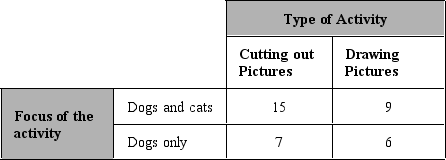Dr.Elder was interested in the way people recognize objects as members of categories.For example,what makes us recognize a dog as being a dog and not a cat? More specifically,he was curious as to whether people think about categories in a more complex way if they contemplate an "opposite" category first.For example,does a person think differently about the category of "southern" if they first think about the category of "northern"? He is also curious as to whether people categorize differently if they are exposed to category members compared with generating category members.Dr.Elder has four groups of participants (with 30 people in each group) .In Group A,participants were told to cut out pictures of dogs and cats from magazines.In Group B,participants were told to cut out pictures of just dogs from magazines.In Group C,participants were told to draw pictures of cats and dogs.In Group D,participants were told to draw pictures of just dogs.After doing this for 30 minutes,participants in all groups were asked to list the attributes that define the "dog" category.Having a higher number of attributes listed was considered to be an indication of thinking about the category in a more complex way.The results of his study are below.

-To determine if there is a main effect for type of activity,Dr.Elder must examine how many marginal means?
Definitions:
Technological Change
Refers to advancements or improvements in technology, which can lead to increased efficiency and productivity in various sectors.
Price Elasticity
The extent to which demand for an item varies with a shift in its cost.
Income Elasticity
An indicator of the variation in demand for a product based on alterations in consumer income.
International Value
The worth of a product, service, or currency as recognized and accepted across different countries and economies.
Q3: Which of the following could NOT be
Q13: Another word for observer effects is:<br>A)Observer bias<br>B)Expectancy
Q19: Which of the following is NOT a
Q21: In addition to measuring the body concern
Q29: A confound that keeps a researcher from
Q33: Which of the following is a difference
Q41: Which of the following is NOT a
Q50: From a Time.com article entitled "Why Men
Q50: Imagine that Dr.Ewell wants to videotape the
Q51: Describe the three sampling problems that could